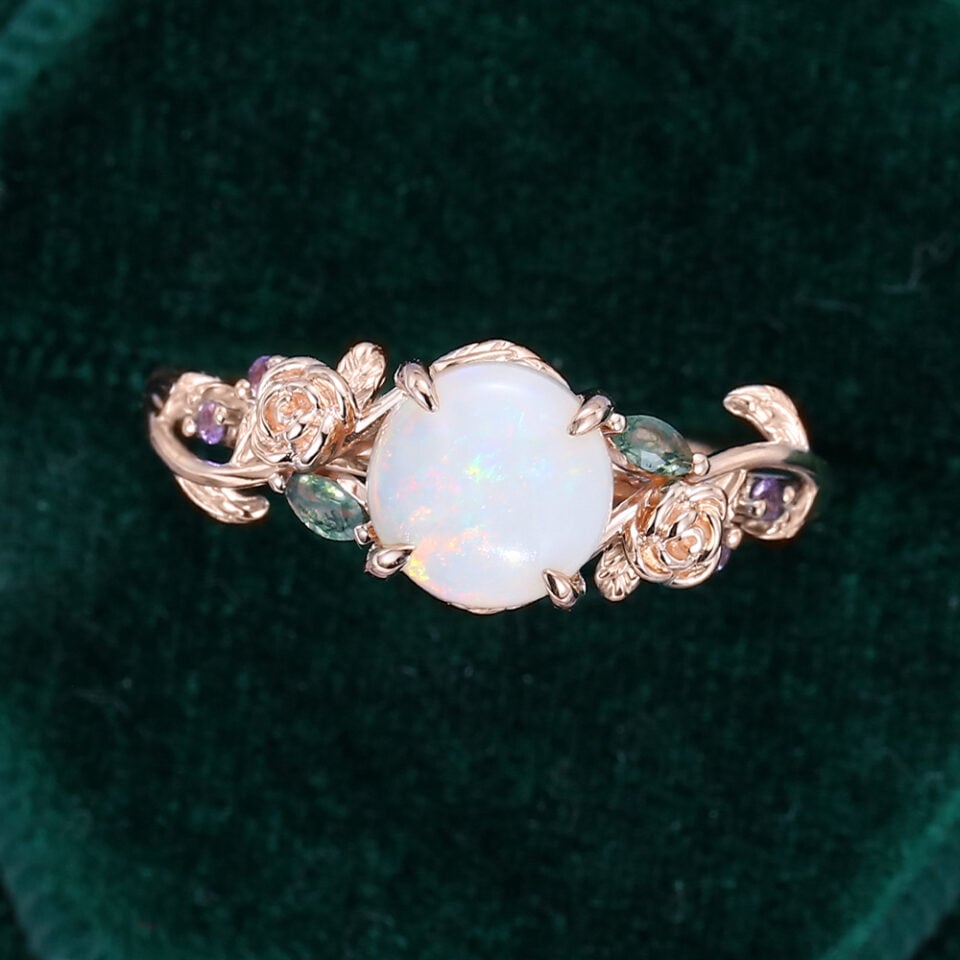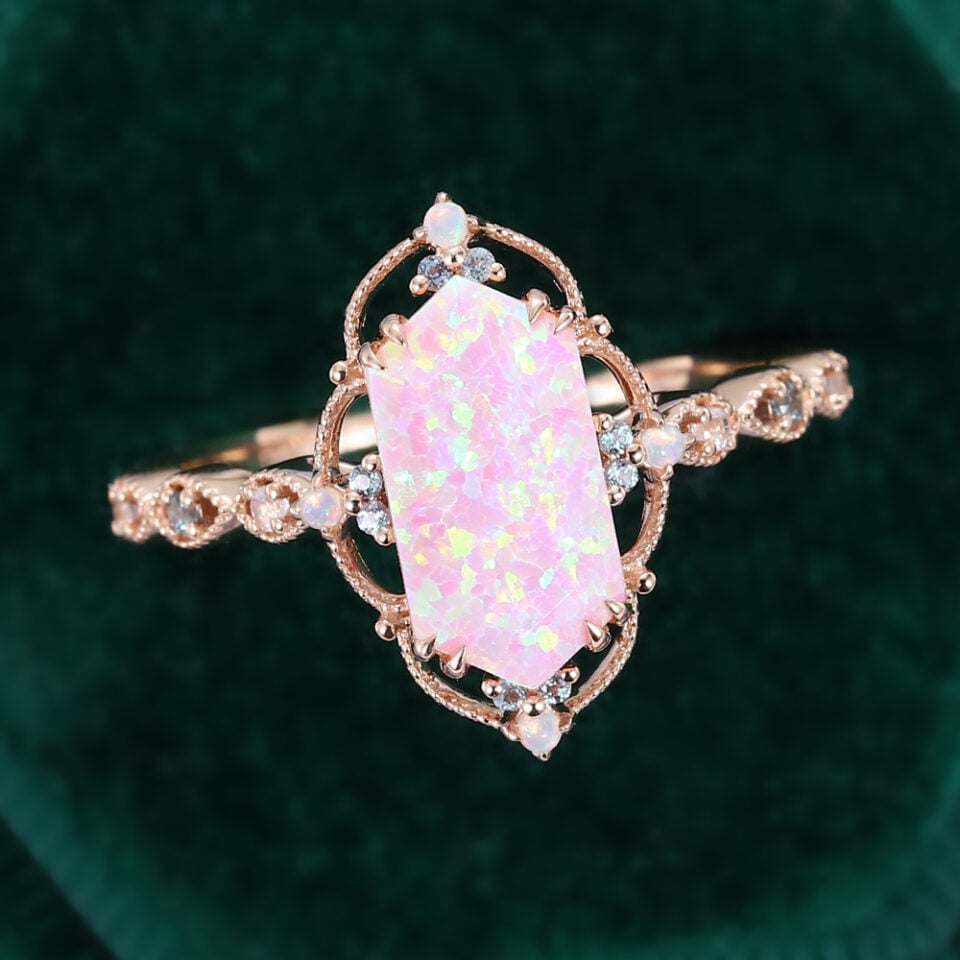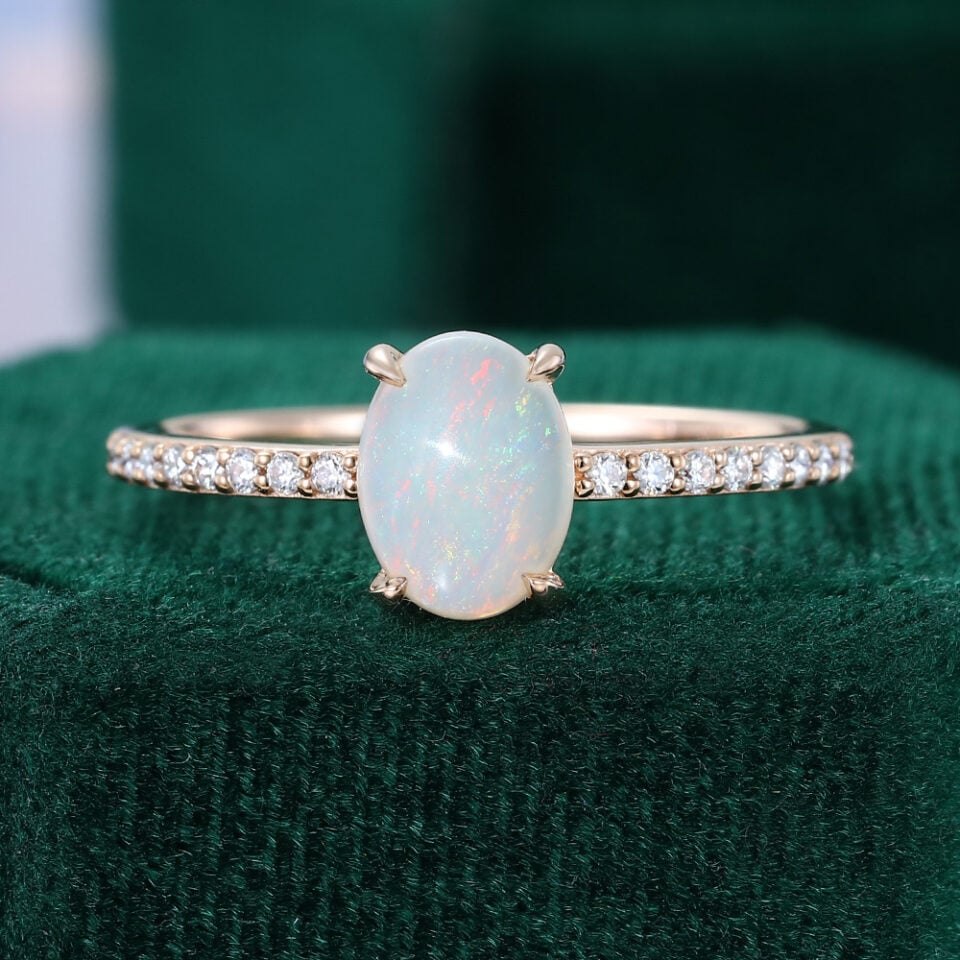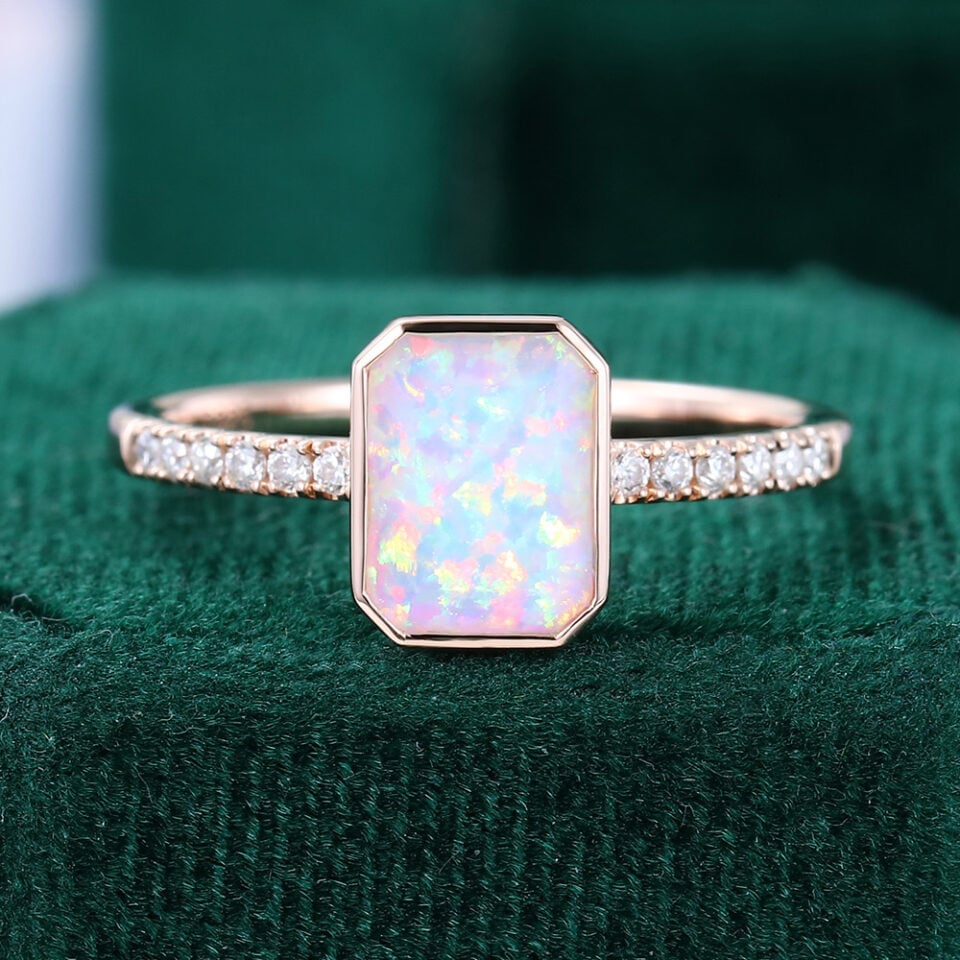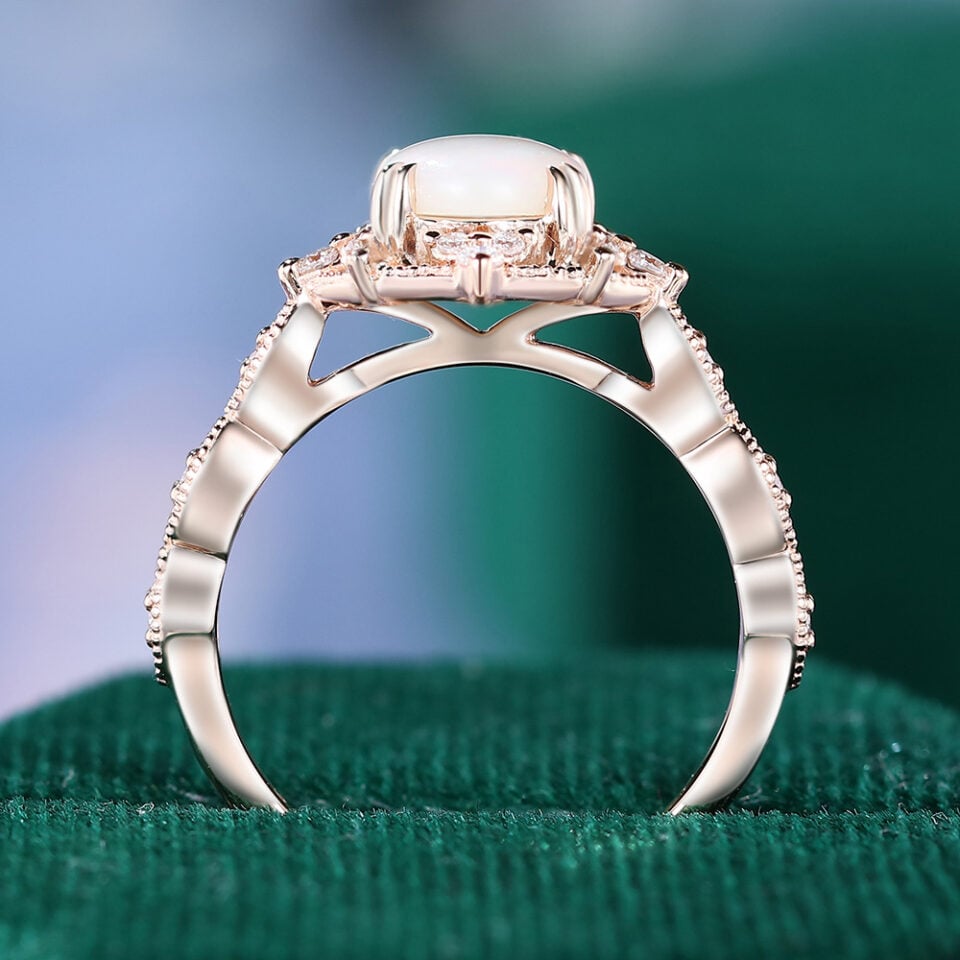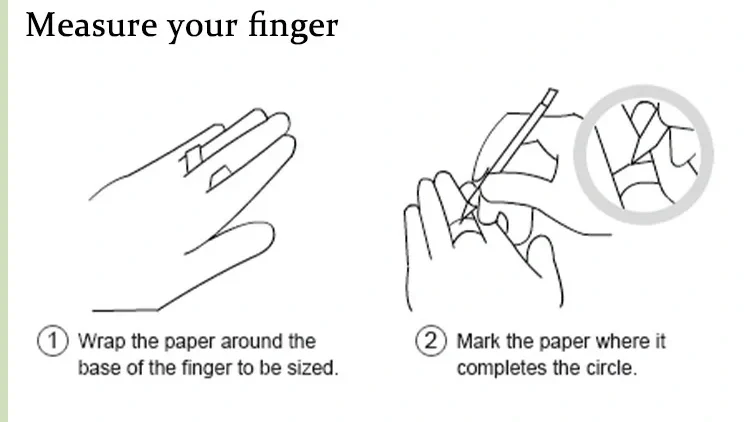- by MollyJewelryUS
- September 17, 2025
- Jewelry Guide
Last updated on October 22, 2025
Opal engagement rings are perfect for those who want a romantic, luminous alternative to traditional diamonds.
With their shifting rainbow hues and deep symbolism, opals represent love, creativity, and emotional depth — making them an affordable and meaningful choice for engagement rings.
Thinking about choosing an opal for your engagement ring?
Explore our full Opal Engagement Ring Collection to find your one-of-a-kind match.
This guide will walk you through everything you need to know about buying an opal engagement ring — from gemstone quality and types to ring styles, settings, metal options, size, budget, and care. By the end, you’ll be ready to confidently choose a ring as unique as your love story.

Table Of Contents:
- How to Choose a Quality Opal: 6 Key Factors
- Budgeting for Your Opal Engagement Ring
- Types of Opals for Engagement Rings
- Best Styles & Settings for Opal Engagement Rings
- Metal Choices for Opal Engagement Rings
- Finding the Right Size & Comfort Fit
- Cleaning & Care Tips
- Where to Buy a Certified or High-Quality Opal Engagement Ring
- Related FAQs
How to Choose a Quality Opal: 6 Key Factors
Learning how to evaluate opal quality is not only the key to finding the perfect opal engagement ring, but also helps you accurately judge whether the price is fair. Below, we break down the selection criteria into 6 core dimensions—easy enough for beginners to follow:
1. Play-of-Color
1. Play-of-Color
Play-of-color is the signature characteristic of opals (rainbow-like flashes created by light refracting through internal silica spheres). Not all opals display play-of-color—only “precious opals” have it. To assess quality, look at three points:
- Brightness: The more saturated the colors (such as vivid red, bright blue, or vibrant green), the rarer and more captivating the stone. If the colors appear faint or grayish, the value is lower.
- Coverage: The more the play-of-color covers the stone’s surface (ideally the entire surface), the higher the quality. If the effect only shows in small areas, it diminishes the overall beauty.
- Dead Spots: “Dead spots” are dull areas with no play-of-color. The fewer dead spots, the better—too many will make an opal look “lifeless,” which is especially undesirable when choosing an engagement ring.
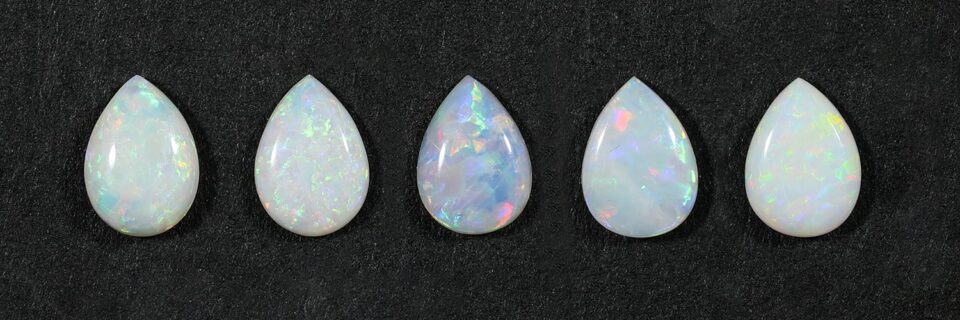
But what about opals without play-of-color? These are called potch. They display a special effect known as opalescence and are more affordable than precious opals. See our Opal Types Guide to learn more.
2. Body Tone
2. Body Tone
The body tone refers to the background color of an opal, which influences how vivid the play-of-color appears. The industry generally classifies it into nine grades, N1–N9. When shopping, pay attention to:
- N1–N4: The darkest base (almost black), which makes play-of-color appear the brightest and most saturated. Strongest visual impact and top choice for value.
- N5–N6: Slightly lighter (dark gray), still showing distinct flashes with a refined look.
- N7–N9: Lighter tones like white or cream, giving softer, more delicate play-of-color.

Key tip: The darker the base, the more vivid the play-of-color—and typically the higher the price. If your goal is to highlight the rainbow effect, choose N1–N6. For a softer, more versatile everyday style, N7–N9 is a better fit.
3. Clarity and Transparency
3. Clarity and Transparency
Besides body tone and play-of-color, clarity and transparency also affect quality. Hold the opal against light to check:
- Transparency: Ranges from opaque to semi-transparent. Semi-transparent opals allow light to pass through, appearing more lively. Fully opaque stones look heavier and suit certain vintage styles.
- Clarity: Look for cracks, inclusions (like impurities or bubbles), or matrix residue. The cleaner and more flawless the stone, the higher the value and durability. (Opals with cracks are more likely to get damaged in daily wear.)
4. Cut and Shape
4. Cut and Shape
Opals are usually cut in two main ways—faceted cuts and cabochon cuts, each cut suits different opal characteristics. Choosing the right cut maximizes beauty, while the wrong cut can waste its potential:
- Cabochon Cut (most common and best for opals): Smooth, domed surface that best displays play-of-color. Ideal for darker body tones (N1–N6).
- Faceted Cut: Multiple flat facets, suitable for higher-transparency opals with lighter bases (N7–N9). The facets enhance light refraction, making the stone look sparkly and elegant.
Shapes like oval, round, pear, and square are all common. Choose according to the ring design (round for a classic engagement ring, pear for something more unique).
5. Carat Weight
5. Carat Weight
We all know larger opals are rarer and significantly more expensive per carat. But did you know opals are less dense than diamonds? This means an opal of the same size weighs less than a diamond—making it more comfortable to wear.

6. Origin
6. Origin
In addition to well-known differences by region, you’ll also need to know whether the opal is natural or lab-grown.
Why does this matter? While natural and lab-grown opals are physically and chemically the same, their value differs:
- Natural opals have higher collectible and resale value.
- Lab-grown opals are more affordable.
At MollyJewelryUS, we offer two types of opals — natural and lab-grown. Whether you’re drawn to the rare allure of natural gemstones or prefer the affordability of lab-created options, you’ll find a ring that fits your style.
If you’re seeking a certified opal engagement ring, look for sellers who provide gem certification or transparent sourcing details.
At MollyJewelryUS, every opal is ethically sourced and carefully inspected for clarity, brilliance, and authenticity — ensuring you get a high-quality opal you can trust.
Budgeting for Your Opal Engagement Ring
How much does an opal engagement ring cost?
Once you’ve decided on an opal engagement ring, the first step is to set your budget. But don’t worry—there’s no “right answer,” no “rules” — just your budget. The key is finding one that fits your budget and excites you.
The price of an opal ring depends primarily on several factors: the size of the gemstone, the number of side stones, and the complexity of the setting. The type of gemstone also influences the price—white opal is generally more affordable than black opal. If you’re looking for a more luxurious 18k gold ring with a black opal, the price will naturally be higher. Regardless of the final price, the most important thing is that this ring will embody your unique love and make your commitment irreplaceable.
Types of Opals for Engagement Rings
The second step is choosing the type of opal. Different opals vary in body tone, play-of-color, and texture, making them suitable for different styles and budgets. Here are 5 of the most popular types to help you quickly find the one that matches your needs:
- White Opal: A classic that “goes with everything.” With its light background and subtle color play, it feels timeless and elegant, while staying moderately priced.
- Black Opal: Known for its dark body tone and striking flashes of color. Rare and eye-catching, it’s perfect for those who love bold styles. Typically more expensive.
- Fire Opal: Features orange, red, or yellow tones, radiating warmth and vibrancy. Ideal for anyone who prefers warm hues and wants to break away from the “cool feel” of traditional gems. Priced between white and black opals.
- Boulder Opal: Naturally formed with an ironstone matrix, giving it a raw, earthy beauty. Great for those who want something unique, nature-inspired, or vintage-leaning. Prices vary depending on the rarity of the patterns but are generally mid-range.
- Crystal Opal: Most famously sourced from Ethiopia, known for high transparency and a fresh, airy look. Perfect for those drawn to a “light, ethereal” style. Available across a wide price range, with excellent options at mid-level budgets.
- Pink Opal: Soft, delicate, and romantic, pink opals add a gentle blush to your ring. Ideal for anyone seeking a feminine, dreamy look, pink opal rings are generally more affordable than black or fire opals.
- Blue Opal: Cool and versatile, blue opals range from light to deep blue. They are perfect for a serene, modern look and are usually more affordable than black opals, slightly higher than white or pink opals.
Each type has its own personality — so let your desired style guide the choice.

Best Styles & Settings for Opal Engagement Rings
When selecting an opal engagement ring, the style determines the overall look and emotional expression, while the setting affects durability and how the play-of-color is displayed. Combining both helps you find a ring that is “beautiful and wearable.” Here’s a step-by-step breakdown:
Step 1: Styles
Step 1: Styles
The style of an opal ring is the core of its design, with different options catering to various aesthetics and emotional meanings. Here are 5 popular styles in 2025:
- Solitaire: A single opal takes center stage; simple and timeless.
- Halo: Surrounded by one or more rows of small diamonds or gemstones, adding sparkle, protection, and making the center stone look larger.
- Vintage: Incorporates vintage-inspired elements such as filigree details, pavé diamond clusters, or engraved patterns, creating a romantic, old-world charm.
- Cluster: Features one or two slightly larger opals as the center stone, accented by multiple smaller gemstones. A balance between solitaire and halo, offering wide design possibilities.
- Nature-inspired: Designs that draw from natural elements, such as petal-shaped settings, leaf textures, or vine motifs. This style has shown a rising trend in 2025.
Among the most popular opal engagement ring styles, opal and diamond combinations continue to be a favorite — the diamond’s sparkle beautifully amplifies the opal’s inner fire.
For something more symbolic, consider an Opal Toi et Moi Ring — representing “you and me,” this two-stone style pairs opal with moissanite or sapphire for a romantic modern look.
Step 2: Settings
Step 2: Settings
The setting not only shapes the appearance of an engagement ring but also directly determines how well the opal is protected. The two most popular types are prong and bezel:
- Prong Setting: Typically 4–6 prongs. Maximizes light entry for the best play-of-color, making it the most classic “stone-showing” setting. (Less protective and may catch on clothing.)
- Bezel Setting: Encircles the girdle of the opal with metal, providing excellent protection, though with less brilliance compared to prong settings.

When considering comfort and stackability, the choice between high and low settings also matters.
- High Setting (e.g., Cathedral): Lifts the gemstone above the band, making the stone stand out more. This design is elegant, eye-catching, and easier to pair flush with other rings. However, high settings are more prone to snagging on fabric.
- Low Setting: Keeps the stone closer to the finger, offering a more subtle profile and better everyday wearability.
Metal Choices for Opal Engagement Rings
Choosing the metal material for your engagement ring is a crucial step, as it not only affects the ring’s appearance but also directly determines its price, comfort, durability, and ease of long-term care. Understanding the characteristics of each metal will help you make an informed choice:
- Platinum: Considered the most premium choice for opal settings, platinum offers exceptional durability, resists tarnishing, and requires minimal maintenance. It provides excellent protection for the gemstone while imparting a luxurious, refined appearance. However, it can be relatively expensive.
- K Gold: Gold, particularly white, yellow, and rose gold, is timeless and classic. It complements both modern and vintage styles and pairs beautifully with fire opals. It’s also relatively affordable, offering excellent value.
- Silver: Silver is an affordable and stylish choice that complements the cool tones of opals and is suitable for crystal and white opals. However, due to its tendency to oxidize, silver requires regular maintenance.
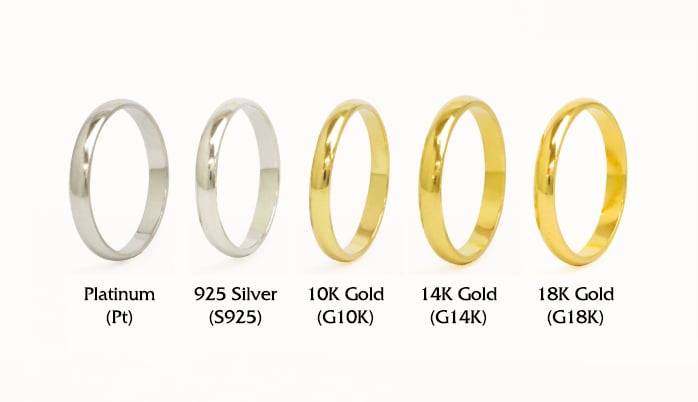
Related: Gold vs. Platinum vs. Silver
Finding the Right Size & Comfort Fit
Choosing the right ring size is just as important as selecting the perfect opal or metal. Your ring should fit like a second skin—comfortable, secure, and easy to wear every day.
Tip: Measure multiple times to minimize errors. Not sure of your size? Use our Ring Size Guide to learn more.
How to Care for Your Opal Engagement Ring?
Opals are soft and easily damaged if not handled with care. Rings worn daily may require periodic maintenance. However, with proper care, they can retain their smooth surface and vibrant color for many years. Opal Aftercare should be mindful of the following:
- Keep away from household cleaners, perfumes, hairsprays, or cosmetics, as these can tarnish the opal’s surface or cause cracking.
- Gently wipe your opal ring with a soft cloth, warm water, and mild soap.
- Wrap the gemstone individually in a soft protective cloth(to avoid scratches from other jewelry) and store away from direct sunlight and high temperatures to preserve its natural moisture and prevent scratches.
- For long-term storage, wrap the opal with a damp cloth or a cotton ball with a few drops of water before storage.
- Regular professional inspection and maintenance (once or twice a year) ensures the opal remains in top condition.
Then, different types of opal require distinct cleaning and maintenance needs. For specific details, please refer to our Opal Jewelry Care Guide.
Where to Buy a Certified or High-Quality Opal Engagement Ring
When shopping for an opal engagement ring, prioritize transparency and craftsmanship over mass production.
Choose retailers who:
-
Clearly state the opal’s origin (Australia, Ethiopia, or Mexico)
-
Provide certification or authenticity guarantees
-
Offer handcrafted settings that protect softer gemstones
At MollyJewelryUS, every opal ring is individually inspected and artisan-set in solid gold or sterling silver — giving you confidence in both beauty and integrity.
Choosing Opal Engagement Ring FAQ
Are opal engagement rings affordable?
Yes! Many of our affordable opal engagement rings under $500 feature genuine opals in solid gold — offering the same romance and artistry at a more accessible price.
Can I find opal and diamond or Toi et Moi designs?
bsolutely. Explore our Opal & Diamond and Toi et Moi collections for creative, romantic interpretations of this timeless gemstone.
What type of opal is best for an engagement ring?
Black opals and crystal opals are highly prized for their vibrant play-of-color, while white opals offer a more subtle and versatile look. The best choice depends on your style and budget.
What setting is most suitable for an opal engagement ring?
Prong settings maximize sparkle but offer less protection, while bezel settings provide more security and durability. If you live an active lifestyle, a bezel or halo design may be the safer choice.
Do opals require special care?
Yes. Opals contain water and can be sensitive to extreme heat, dryness, or chemicals. Clean gently with a soft cloth and mild soapy water — avoid ultrasonic cleaners. Store separately to prevent scratches.
Are natural or lab-grown opals better?
oth are genuine opals with the same physical properties. Natural opals hold higher rarity and long-term value, while lab-grown opals are more budget-friendly and sustainable. At MollyJewelryUS, we clearly label all lab-grown opals with “Lab” for easy identification.



